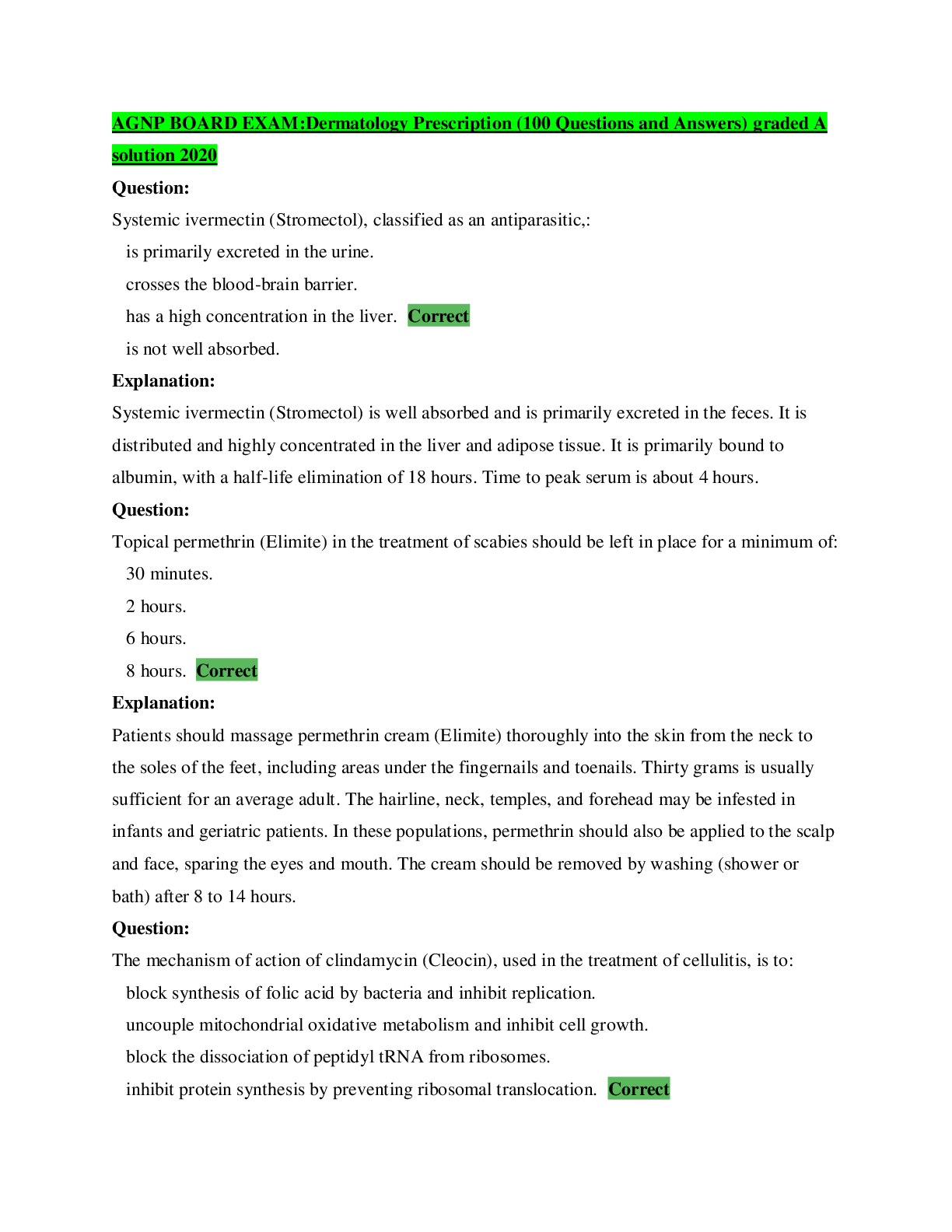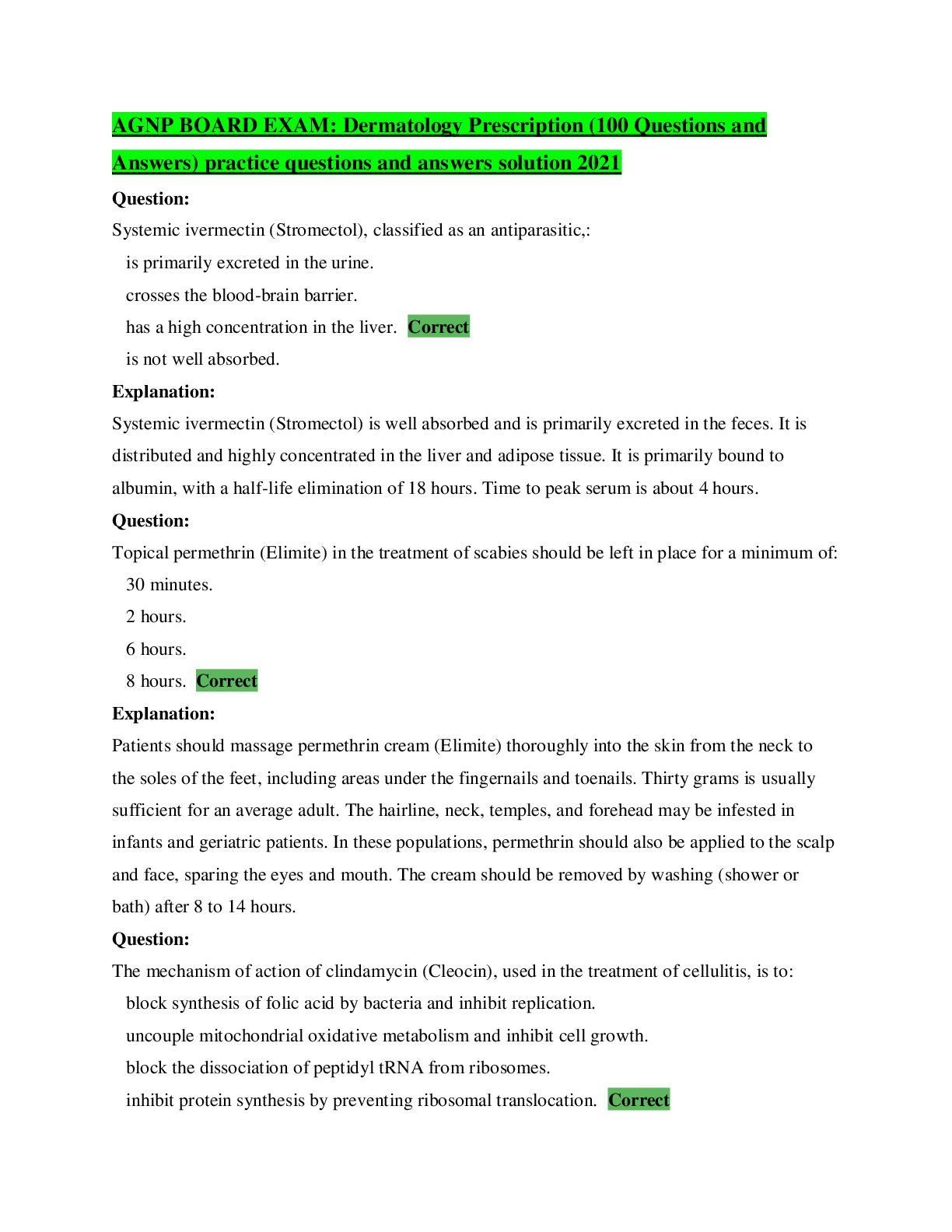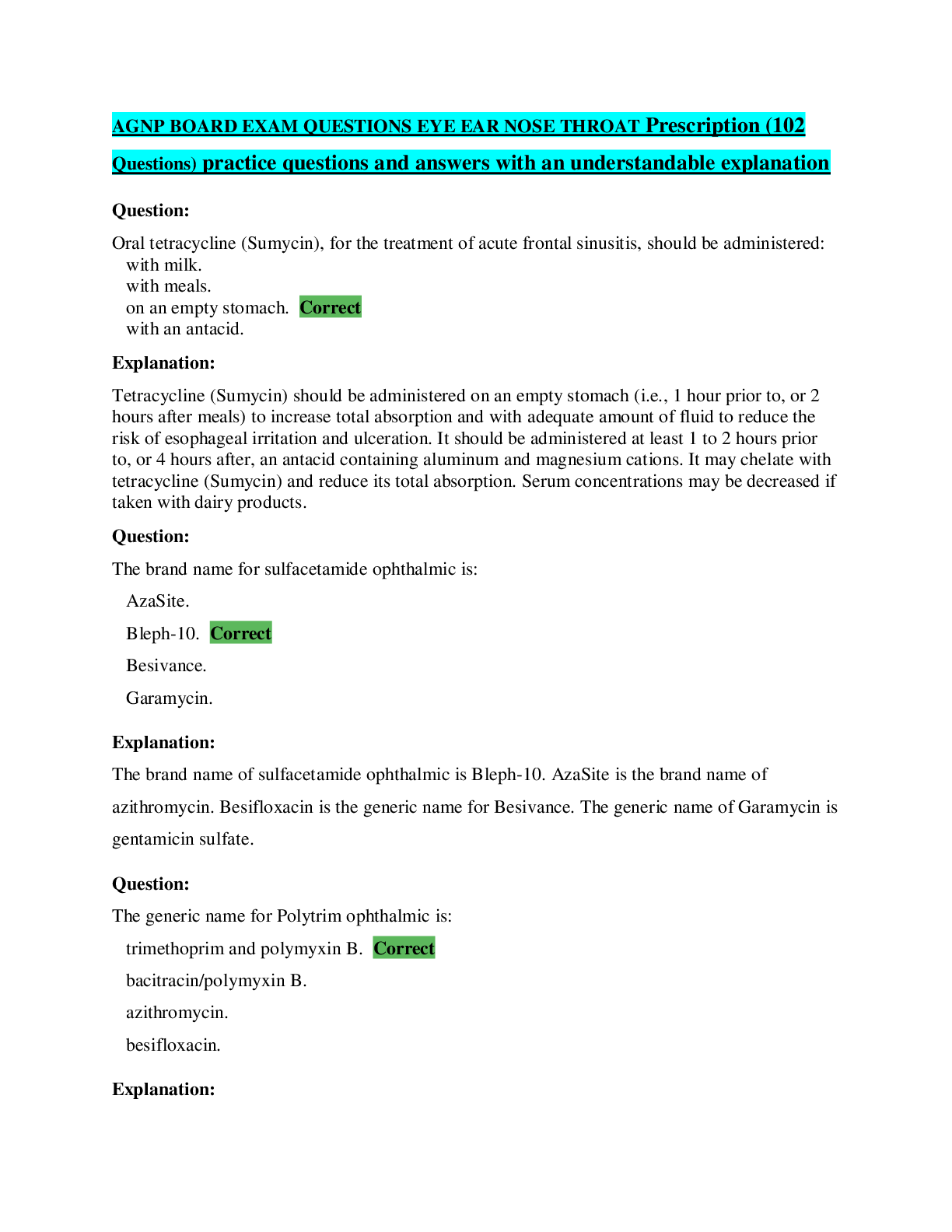*NURSING > QUESTIONS & ANSWERS > South University, Savannah NSG 6320 AGNP BOARD EXAM QUESTIONS Neurology Assessment Already Passed (All)
South University, Savannah NSG 6320 AGNP BOARD EXAM QUESTIONS Neurology Assessment Already Passed
Document Content and Description Below
AGNP BOARD EXAM QUESTIONS Neurology Assessment (Questions 194) Question: When eliciting deep tendon reflexes in the knee, the nurse practitioner notes an abnormal reflex in the right knee. This abn... ormality is probably consistent with a pathological lesion in which segmented level of the spine? Cervical 5 and 6 Cervical 6 and 7 Lumbar 2, 3, and 4 Correct Sacral 1 Explanation: The segmented levels of the deep tendon reflexes are: Ankle: sacral 1; knee: lumbar 2,3, & 4; Supinator and biceps: cervical 5 & 6; and triceps: cervical 6 & 7. Question: A 80 year old male visits the nurse practitioner for an annual well exam. History reveals two falls in the prior 12 months and difficulty with balance. The next step the nurse practitioner should take is: reassess the patient in 6 months. obtain cognitive and functional assessment. Correct assess respiratory assessment. assess cardiac function. Explanation: High-risk older adults, namely those with a single fall in the past 12 months with abnormal gait and balance and those with two or more falls in the prior 12 months, an acute fall, and/or difficulties with gait and balance, require further assessment to determine the reasons for the falls. Obtaining relevant medical history, physical exam, cognitive and functional assessment and determining multifactorial fall risks are essential to the preventing future falls. Question: When evaluating the sensory system, testing the spinothalamic tracts would include assessing sensations of: position and vibration. pain and temperature. Correct deep touch. discriminative sensations. Explanation: When evaluating the sensory system, testing the spinothalamic tracts would include assessing sensations of pain and temperature. Assessing position and vibration evaluate the posterior columns. Light touch assesses both the spinothalamic and posterior column tracts. To assess discriminative sensation, both the spinothalamic and posterior columns tracts as well as the cortex would be assessed. Question: When testing for corneal reflex, an absent blink reflex is noted. This finding may be suggestive of a lesion in which cranial nerve? Cranial Nerve II (CN II) Cranial Nerve IV (CN IV) Cranial Nerve VI (CN V) Cranial Nerve VII (CN VII) Correct Explanation: When testing for corneal reflex, an absent blink reflex would be suggestive of a lesion in cranial nerves V or VII (CN V or CN VII)-Trigeminal or facial nerves. Question: An example of symmetric weakness is: the right shoulder. the right hand. both arms. Correct one the right side of the face. Explanation: There are 4 different patterns of weakness: Proximal, distal, symmetric, and asymmetric. An example of proximal weakness is weakness in the shoulder or hip girdle. Distal weakness occurs in the hands or feet. Symmetric weakness occurs in the same areas on both sides of the body. An asymmetric weakness occurs in a portion of the face or extremity - a form of focal weakness. Question: One maneuver used to assess coordination is to observe the patient: dorsiflexing the ankle. walking heel-to-toe in a straight line. Correct squeezing the examiner's fingers. counting to 10 backwards. Explanation: To assess coordination, observe the patient’s performance in rapid alternating movements, point-to-point movements, gait and other related body movements, standing in specified ways. Walking heel-to-toe would be an example of observing the patient's gait. Dorsiflexion would be assessing the patient's joint function. Squeezing the examiner's fingers would be one way to assess hand grasp. Counting has nothing to do with coordination. Question: Assessment of a 70-year-old's ability to maintain personal safety would be most adversely affected by declining function in the: cardiovascular system. respiratory system. sensory perception system. Correct gastrointestinal system. Explanation: The sensory system or sensory perception involves vision, touch, taste, smell, and hearing. With the aging process these perceptions are altered and these alterations put the elderly at risk for falls, burns, inability to smell smoke, and the inability to move fast enough to get out of harm's way. These impact personal safety. Changes in the cardiovascular, gastrointestinal, and respiratory systems do not usually lead to safety issues. Question: A patient complains of experiencing symptoms of nausea, diaphoresis, and pallor triggered by a fearful or unpleasant event. These symptoms are most likely associated with: subarachnoid hemorrhage. stroke. neurocardiogenic syncope. vasovagal syncope. Correct Explanation: In vasovagal syncope, a common cause of syncope, a prodrome of nausea, diaphoresis, and pallor are triggered by a fearful or unpleasant event, then vagally mediated hypotension, often with slow onset and offset. In syncope from arrhythmias, onset and offset are often sudden, reflecting loss and recovery of cerebral perfusion. Stroke or subarachnoid hemorrhage are unlikely to cause syncope unless there are focal findings and damage to both hemispheres. Question: An infant presents with an inappropriately increasing head circumference and hydrocephalus confirmed by CT scan. In addition to these findings, which one of the following would also be consistent with hydrocephalus? A soft, low-pitched cry Ability to be comforted easily Tense, bulging fontanels Correct Appropriately increasing weight Explanation: An infant with newly diagnosed hydrocephalus presents with a shrill and high-pitched cry. They are very irritable and do not comfort easily. Additionally, the infant's fontanels are tense and bulging due to the increased amount of cerebral spinal fluid (CSF) being produced or not being absorbed. These infants are very difficult feeders, so they often do not gain weight appropriately. Question: Postural tremors appear when the affected part is: at rest. moving voluntarily. is actively maintaining a posture. Correct getting closer to its target. Explanation: Tremors are rhythmic oscillatory movements. Postural tremors appear when the affected part is actively maintaining a posture. Examples include the fine rapid tremor of hyperthyroidism, the tremors of anxiety and fatigue, and benign essential tremor. The other choices are not consistent with postural tremors. Question: Dysphonia refers to: the inability to produce or understand language. the loss of voice. an impairment in volume of the voice. Correct a defect in the muscular control of the speech apparatus. Explanation: Dysphonia refers to less severe impairment in the volume, quality, or pitch of the voice. Aphonia refers to a loss of voice that accompanies disease affecting the larynx or its nerve supply. Dysarthria refers to a defect in the muscular control of the speech apparatus (lips, tongue, palate, or pharynx). Aphasia refers to a disorder in producing or understanding language. Question: Symptoms of a migraine headache can include throbbing, nausea or vomiting, duration of one day, and be unilateral and/or disabling. How many of these symptoms should be present to classify the headache as a migraine? One of the five Two of the five Three of the five Correct Four of the five Explanation: A migraine headache is highly likely if three of the five “POUND” features are present: Pulsatile or throbbing; One-day duration, or lasts 4 to 72 hours if untreated; Unilateral; Nausea or vomiting; Disabling or intensity causing interruption of daily activity. Question: The cranial sutures are closed on the head of a 9 month old infant. This indicates: hydrocephalus. craniosynostosis. Correct a normal finding. opisthotonos. Explanation: Craniosynostosis is defined as the premature closing of the sutures in young children. When this occurs, a bony ridge can be felt along the suture line. This is not a normal finding since the sutures usually fuse between 12 and 18 months. Hydrocephalus refers to fluid on the brain and would appear as an enlarged head with sutures remaining open. Opisthotonos is a state of severe hyperextension and spasticity in which an individual's head, neck and spinal column enter into a complete "bridging" or "arching" position. This abnormal posturing is an extrapyramidal effect and is caused by spasm of the axial muscles along the spinal column. Question: When upper motor neuron systems are damaged above the crossover of its tracts in the medulla, motor impairment develops on the opposite side. This term is: ipsilateral. contralateral. Correct superficial. intermediate. Explanation: When upper motor neuron systems are damaged above the crossover of its tracts in the medulla, motor impairment develops on the opposite side. This term is contralateral. In damage below the crossover, motor impairment would occur on the same side or ipsilateral side. Superficial refers to the outer surface of something. Intermediate is a term used to denote something between two other structures. Question: The best method of detecting cognitive impairment or intellectual disability at an early age is by: performing neuropsychological testing of intelligence. administration of an IQ test of cognitive abilities. radiographic evaluation of the brain and brainstem. assessment of the achievement of developmental milestones. Correct Explanation: The least invasive, least expensive, most efficient strategy used to detect cognitive and developmental deficits in infants and children is assessing for achievement of developmental milestones. Delay in achievement of developmental milestones is a cardinal sign of deficits/disabilities. The other three choices may be done at a later date as the child gets older and after the child is identified as having delayed or failure to achieve milestones. Question: A term used to describe an increase in muscular bulk with diminished strength is: hypertrophy. muscular atrophy. pseudohypertrophy. Correct muscle weakness. Explanation: An increase in muscular bulk with diminished strength is known as pseudohypertrophy. Hypertrophy refers to an increase in bulk of the muscle with a proportionate increase in strength. A term used to describe muscle wasting or loss of muscle bulk is muscular atrophy. Muscular weakness is a term used to describe a lack of strength or firmness in a muscle. Question: A 40-year-old male presents with complaints of headaches. History reveals headaches that occurred daily for about 4-6 weeks. He had relief for 6 months but now they are recurring. These are most likely: tension headaches. cluster headaches. Correct migraine headaches. sinus headaches. Explanation: Headaches that are episodic with several each day for 4-6 weeks with an extended period of relief for 6-12 months are most likely cluster headaches. Cluster headaches are more common in men than women. Question: It is imperative to assess for suicidality and bipolar disorder in patients suspected of experiencing: delirium. autism spectrum disorder. depression. Correct attention deficit disorder. Explanation: Depression is more common in individuals with significant medical conditions, including several neurologic disorders—dementia, epilepsy, multiple sclerosis, and Parkinson disease. Patients who present with depression may actually have bipolar disorder and so screening should always take place. Patients who are depressed may be suicidal. Consequently, in order for appropriate treatment to occur, appropriate diagnosis must occur. Question: The level of consciousness that refers to the patient that remains unarousable with eyes closed without evidence of response to inner need or external stimuli is said to be in: an obtunded state. a comatose state. Correct a lethargic state. a stuporous state. Explanation: A patient that remains unarousable with eyes closed without evidence of response to inner need or external stimuli is a comatose patient. An obtunded patient opens his eyes, looks at the person speaking to him but responds slowly and appears confused. Lethargy refers to the patient that appears drowsy but can open his eyes, respond to questions, then fall back to sleep. A stuporous patient arouses from sleep only after painful stimuli. Question: Brief, repetitive, stereotyped, coordinated movements occurring at irregular intervals are consistent with: facial tics. Correct dystonic movements. athetoid movements. oral-facial dyskinesias. Explanation: Facial tics are brief, repetitive, stereotyped, coordinated movements occurring at irregular intervals. Examples include repetitive winking, grimacing, and shoulder shrugging. Dystonic movements are similar to athetoid movements, but often involve larger portions of the body, including the trunk. Grotesque, twisted postures may result. Athetoid movements are slower and more twisting and writhing than choreiform movements, and have a larger amplitude. They most commonly involve the face and the distal extremities. Oral [Show More]
Last updated: 2 years ago
Preview 1 out of 63 pages

Buy this document to get the full access instantly
Instant Download Access after purchase
Buy NowInstant download
We Accept:

Reviews( 0 )
$14.00
Can't find what you want? Try our AI powered Search
Document information
Connected school, study & course
About the document
Uploaded On
Apr 22, 2022
Number of pages
63
Written in
Additional information
This document has been written for:
Uploaded
Apr 22, 2022
Downloads
0
Views
114

.png)






















